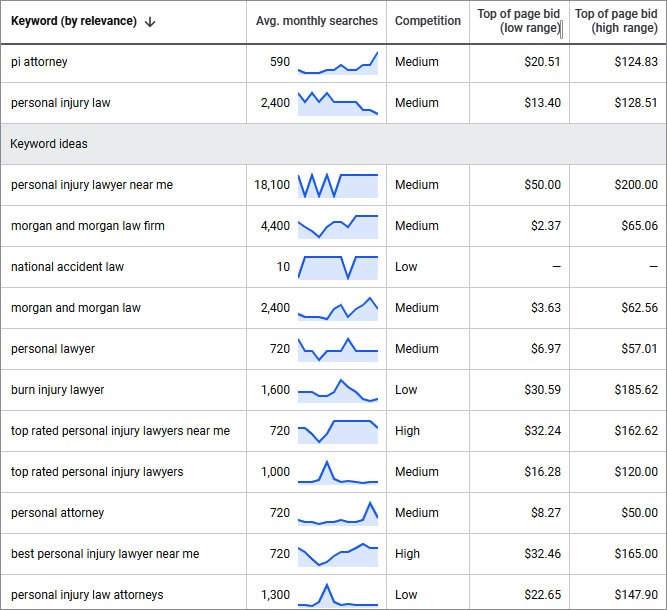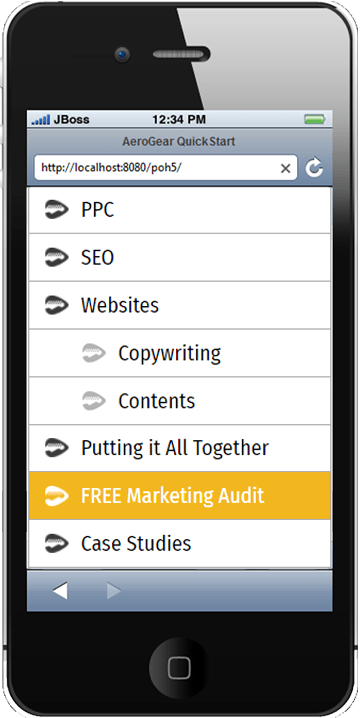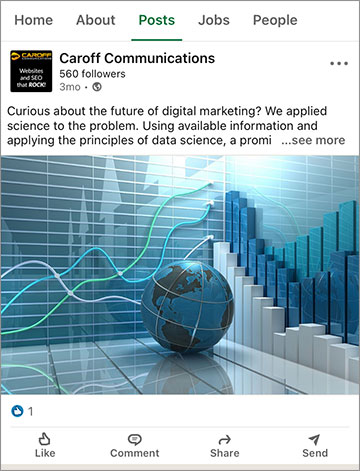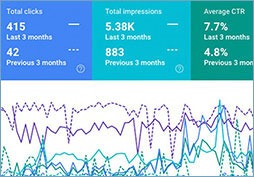While it is true that Search Engine Optimization (SEO) and Pay-Per-Click (PPC) marketing are two different animals, there is enough commonality to provide a great amount of efficiency when doing them together.
So, read on for our step-by-step guide to maximizing the effectiveness of your combined digital marketing campaign.
1. Determine the best keywords for your company
First of all, though the term “keyword” is still in common use, a more appropriate word in today’s online marketplace is “topics.” For an explanation, see our article: Are keywords a thing of the past? Actually, yes.
(NOTE: For the purposes of this article, we will use several terms synonymously: keywords, topics, terms, search phrases.)
A variety of tools exist to help you find relevant topics; one of the best is Google Ads Recommendations. Not only can you find anywhere from dozens to thousands of terms for any subject, but you can also see current numbers of searches per month, narrow it down by geographic area, and get a good sense of the competition.

2. Create dedicated content for specific keyword phrases

Put yourself in the searcher’s shoes. If someone searches on “chrome-plated light weight bicycle handlebars,” that is what they want to find. Should your site contain a page with good, well-written information about exactly that, then whether the searcher finds you via an organic (SEO) or paid (PPC) listing, they are likely to become engaged with your website.
Make sure that your page is optimized for conversion. That is, give the viewer obvious CTAs (Calls to Action). These could be a link to purchase, a newsletter sign-up form, a contact us button, etc.
3. Create Ad Groups in Google Ads that match the keywords and the Landing Pages
Doing this will help you segment out that specific category within your business. Thus you can continually refine your approach within Google Ads to increase your ROI. (You will also gain valuable information for your SEO campaign; we will cover that in more detail later on in this article.)
4. Post your content on Social Media channels
Each channel offers its own audience and flavor, but sharing your content on any of the sites will result in at least three tangible benefits:

People already on that channel may discover your content directly, or via shares.
Because Social media channels enjoy a strong search presence, you may find your listing coming up in Google searches.
Finally, all this exposure may lead to backlinks from other websites.
5. Employ Remarketing to stay in front of people who have visited your site at least once
Because Google’s Remarketing function is so robust, you can segment out your campaigns by subject matter. Which means that once people have visited a certain area of your website, you can stay in front of them when they are viewing related content, and bring them back to the same page.
Bonus: A data-miner’s dream
As your campaign unfolds, you will be receiving actual search data in real time. This will be invaluable for tailoring your SEO strategy in regards to that subject area. In other words, the short-term data delivery provided by PPC enhances your long term strategy via SEO.
SEO and PPC strategy
SEO vs PPC
Each of these two channels have unique qualities and strengths. Google Ads generates impressions and clicks incredibly quickly, which means you can see the results unfold day-by-day in your campaign. On the other hand, SEO takes much longer to work, so it may be months before you see the effects of your efforts begin to pay off.

As time goes on, however, a well-run campaign will begin to see the ROI from SEO climb steadily because of the cumulative nature of the channel. PPC, on the other hand, tends to have a much flatter curve.
How to integrate PPC and SEO
The general approach is to employ your Google Ads channel to cast a “wide net,” using popular short-tail keywords that enjoy high traffic.
The immediate effect of this is to generate a large number of clicks to your landing pages, while simultaneously gathering data on the actual search terms that people are using to get see your ads. Your conversion rate will necessarily be low because of the broad nature of the approach, so you don’t want to do this for too long.
Over time, by using the “Search Query” data from your Google Ads stats (these are also available within your Google Analytics account), you will see the actual terms people are typing in. This will both inform the development of your PPC strategy and give you target terms for your SEO approach.
The value of long-tail keywords
- Short-tail example: bicycle parts
- Long-tail example: chrome-plated light weight bicycle handlebars
Remember the example we discussed above? If a viewer sees your ad and clicks through to your website with the short-tail term, the odds of them finding exactly what they want immediately are relatively low.
Contrast that with the viewer who searches for the long-tail term. They know exactly what they’re looking for, and assuming that you have done your job properly and they find that exact content on your landing page, the chances of them moving further along in the sales funnel are great.
Short-tail terms generate a far greater number of clicks, with a relatively low conversion rate. Long-tail terms deliver substantially lower clicks, but are much more effective at conversions.
In the end, you will want to use every tool at your disposal — SEO, PPC, landing pages, short-tail terms, long-tail terms, etc. — to craft an effective digital marketing strategy.
And always remember, there is no “magic bullet!” Just time, expertise, hard work, and perseverance.







